Going through memorabilia, I found some old school reports. So here is a comparison of my "Report of Progress" from Year 5, in 1980 at what was then Lindfield Demonstration School, in Sydney, Australia, and my daughter Helen's "Annual Learning Journey Report" from Year 5, in 2022-2023 at Larkrise Primary School, in Oxford, England.
My report consists of four A4 sheets stapled between thin cardboard covers. It was produced on a typewriter and then presumably mimeographed or photocopied, with the teacher writing in it by hand. The last sheet is blank on one side and uses the other for an appointment booking, so with the inside of the front cover used it has seven pages of information. Helen's Year 5 report is a PDF with five pages of information.
Presumably because it was so difficult to produce, my report has everything doubled up so it could be used twice: it was sent out in mid-year (June) and then used again at the end of the year (November). It was one of the few formal communications from the school to parents: back in 1980 there was no email and no web. In contrast Helen's report covers the whole year, but was just one among many communications between the school and parents, including a weekly newsletter. (But will Helen be able to find any of that - or indeed her report - in forty-five years?)
My report starts with a page on the general aims of education and the school's aims. Helen's report has nothing like that.
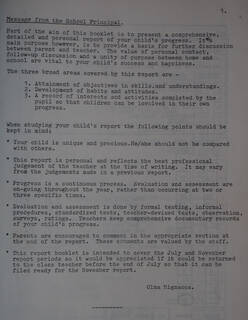 |
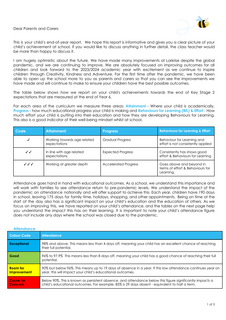 |
My report has a page from the head teacher on how to read it. Helen's report has something similar, but half of it is about the importance of attendance. My report has nothing on attendance at all. (I have memories of not infrequently taking "sickies", with my mother taking my sister and me to do something fun instead of going to school.)
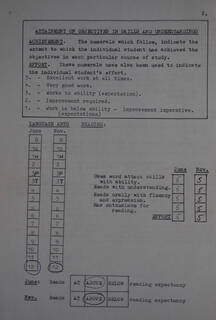 |
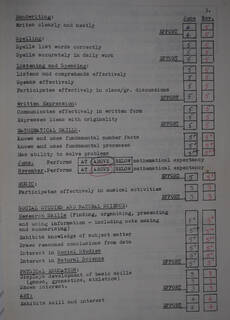 |
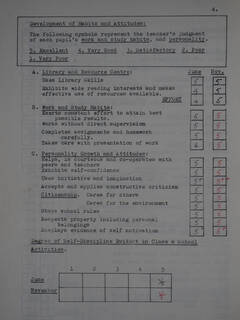 |
Reading takes precedence in my report: it starts by marking which of the "language arts" (basically reading and writing) classes I was in - my school had fifteen graded groups for this, into which children in the upper school (years 3 to 6) were divided separately from their year groups. (I think I was the first student ever to be put into the top group immediately on entry into year 3.) Helen's report starts with percentages for attendance and authorised and unauthorised absences, and her number of "lates".
My report gives fully fifty 1 to 5 grades, eleven of which were for effort, along with two "below / at / above" gradings, for overall reading and mathematics, and a 1 to 5 grade for "degree of self-discipline evident in class & school activities". Helen's report is all "working towards / in line with / at greater depth" grades, and there are 21 of those, with attainment, progress and behaviour/effort grades for each of 7 categories. (The number of grades in my report seems quite excessive; I'm skeptical of how useful even the more limited number of grades in Helen's are.)
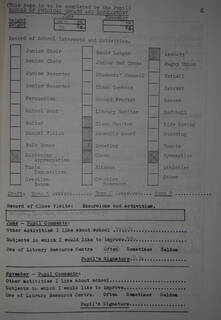 |
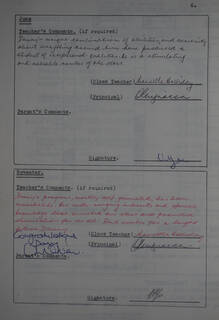 |
My report has space for me to record my non-academic "interests and activities", my height and weight, and class visits and excursions. None of that is in Helen's report.
My report has one line for me to write in "subjects in which I would like to improve". Helen wrote in (at school) whole paragraphs on "an area of school work that I have been most proud of", "my favourite memory this year" and "next year I would like to improve".
My report has a paragraph of "teacher's comments" for each half-year, with room for parent's comments (which my mother didn't write anything in). Helen's report has similar teacher's comments, but also a "Next Steps" with specific suggestions for "English - Reading", "English - Writing", "Mathematics", and "Behaviours for Learning".
The broader picture
There is a lot that is unchanged, across forty five years and across the world. Most obviously, both schools have/had thirty children to a class, progressing in lockstep through years, with roughly similar staff-student ratios.
- English primary schools such as Larkrise have a greater focus on metrics - as well as the obsession with attendance, they have external testing in Year 2 and Year 6 (SATS) and phonics and times tables checks in Year 1 and Year 4. Lindfield Dem had an optional test in Year 4 which siphoned off the more academic students to an "Opportunity Class" at Artarmon primary school and another optional test in Year 6 for entry to selective high schools.
- I think mathematics has relatively more prominence at Larkrise - roughly coeval with English, and Helen thinks even above that - than it did at Lindfield Dem. STEM wasn't a thing in 1980: mine was one of the few families with a computer at home, and no one knew that in fifteen years maths graduates would be able to earn a fortune in finance.
- Teaching approaches at Lindfield Dem differed more between classes: my Year 5 teacher was more 'progressive'; my Year 6 teacher had us sitting rigidly in rows of desks facing a blackboard. This is possibly because New South Wales schools had teachers assigned to them by the Department for Education, whereas English schools get to select their own teachers, resulting in variation between schools instead.
- Lindfield Dem may have had more support staff - it had a specialist librarian, for one thing, and secretaries who did typing and mimeographing - but fewer teaching assistants.
- School lunches weren't a thing at Lindfield Dem; children brought their own. There was a vastly higher number of stay-at-home parents, almost all mothers.
- SEN provision is better at Larkrise. I'm not sure there even was such a thing at Lindfield Dem, but I think New South Wales had a larger network of special needs schools. Autism only really became a diagnosis that very year, with the publication of DSM-III; in a modern school environment ten-year-old me would have been diagnosed before anyone could blink.

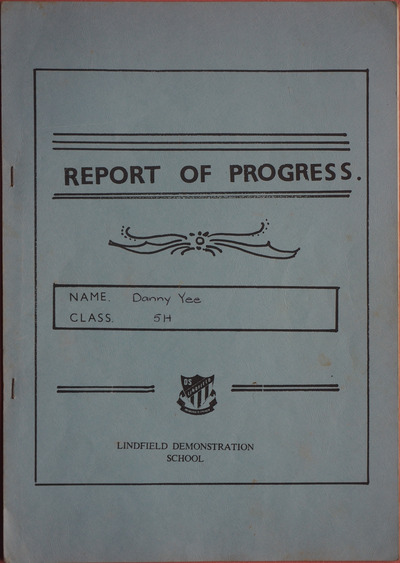
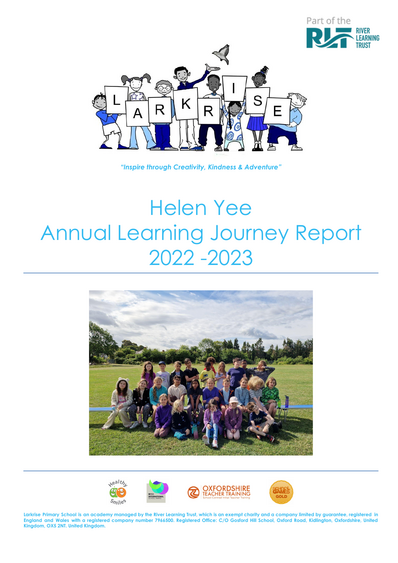
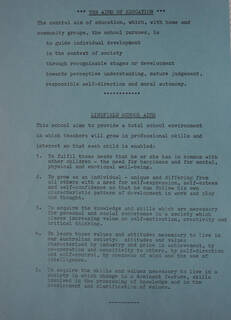
Dear Mr Yee
Most interesting to read your Year 5 report. I’m guessing 5H might have been Fiona Huddleston was the teacher. Reports in that period were in transition from the older single sheet with percentages to one that tried to represent progress in different areas of child development. This was why it was more ‘stapled together and handwritten’. To me it wasn’t as professional as you’d want, but Olma Mignacca, Principal from 1978-1988, (she died last year) was trialling different formats. This was as you rightly point out in the days of typewriters, no computers and certainly no NAPLAN testing as is done now.
Lindfield got its first computers in the classrooms in 1989 or so. I remember my friend and colleague Ruskin Donlan (who died in 2004) playing an early computer game on it. I was at Lindfield from 1977 to 1990, and retired in 2012.
I grew up in England and was nine years old coming to Australia. I did miss school dinners in England but not the fear of what was called the ‘Eleven Plus’ which would give you entry to the grammar school. I don’t think there are any left now.
My best wishes
Ronald Skelly.
My teacher for Year 5 was Mrs Halliday - maybe Narelle from the signature, I can't tell. I was there from 1975 to 1981. Were you a teacher?
Dear Mr Yee… Danny…
Yes I was there for fourteen years from 1977 to 1990 when I took promotion to Deputy Principal. I taught mostly Year 4 and Year 3 with occasionally a Year 5 and a Year 5/6 composite. I had students for dems up until 1983 when Kuring-Gai College stopped them. Lindfield was my second school and was a good grounding for my career. After retiring I taught part time and also still at Macquarie University and Barker College in Hornsby.
I worked out your teacher’s signature. I believe it to be Marcelle Holliday. She was Marcelle Moody when I came and married Royce Holliday, also a teacher there. I heard quite by chance that she died about two years ago. I still keep in touch with Marion Greene, who was the librarian, and others of that era. I have not been to Lindfield Public as it is now for twelve years or so. There was a centenary in 2003 but I was overseas at the time - coincidentally in Norway. I recall being in Alesund about then and paying the equivalent of $35 for one roll of Kodachrome film.
Ron Skelly
Hi Ronald, thanks for all that information. I'm sorry to hear about Marcelle passing away - she was my favourite teacher of all time. And I remember Mrs Greene, too. The library was always a great place for a bookish nerd!